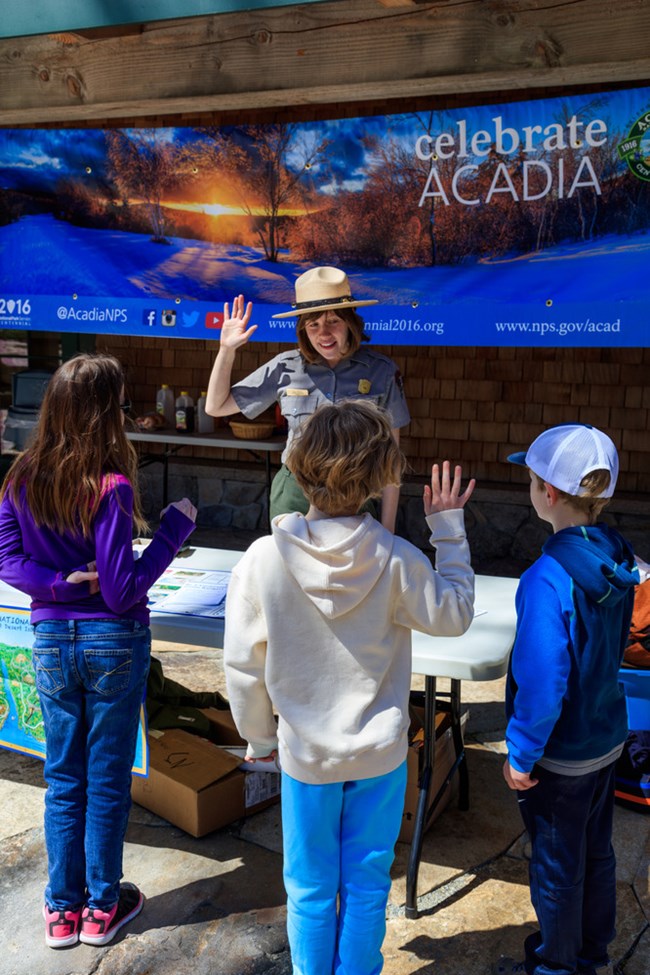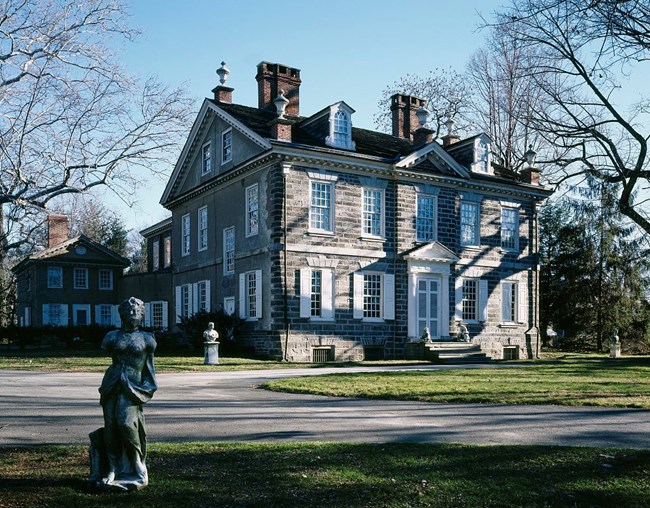Part of a series of articles titled Teaching with Historic Places Program and Where Did History Happen?: Selections from CRM, Vol 16, no 2 (1993).
Article
Teaching with Historic Places: Heritage Education: What is Going On Out There?

NPS photo.
Selections from a Thematic Issue of CRM Vol 16 No. 2 1993
Published by the National Park Service, Cultural Resources
By: Kathleen Hunter
Heritage Education: What is Going On Out There?
History discovery trunks, walks around the neighborhood, field trips, adopt-a-building projects, community planning simulations, and historical reenactments are a few of the many approaches of heritage educators. In the United States, interpreters, or “heritage educators,” at museums and historic sites – always important tourist attractions – long have conducted programs for school children. Since the 1970s, however, heritage education has expended from the museum or park setting into communities and their schools.
Heritage educators do not always share professional standards or goals. There are some common elements to their programs, however. Activities focus the learners’ attention on the actual evidence of our history and culture, such as the natural and built environment, material culture, practices, oral history, music and folkways. Then the heritage education approach engages learners in an interactive exploration of this evidence. This approach also encourages learners to move from idea to action – from understanding the historical environment to protecting it. Finally, it draws on many disciplines – history, geography, the natural and social sciences, the arts and literature – to decipher meaning and significance.
Historic house museums and historic sites have shown a concerted effort to strengthen interpretive programs to give visitors a more complete and accurate story. House museums are finding creative ways to tell their story to learners of every age. At Shadows on the Teche in Louisiana, for example, youngsters portray the children of the Weeks family who owned the plantation. An Arlington, VA, high school class visits Woodrow Wilson’s home in Washington, DC each year for a simulated League of National meeting. Students visiting Drayton Hall in Charleston, SC learn archeological skills.
Living history museums – such as Williamsburg, VA and Greenfield Village, MI – offer a wide range of interactive learning opportunities, allowing visitors to connect with the period and culture being presented. They combine fixed exhibits and preserved structures and artifacts with demonstrations, reenactments, performances, and opportunities to explore historical evidence.

Photo by Carol Highsmith, Library of Congress.
Programs developed by historical societies tend to emphasize investigation into the community’s people and events. In Hunterdon County, NJ for example, high school students have compiled valuable documentation on country residents for the historical society. The Kentucky Historical Society supports an extensive collection of books, films, and other materials for school-aged children. In the Philadelphia area, Cliveden House in Germantown not only teaches youngsters about events at the house itself, but also about many aspects of local history.
Preservation organizations sponsoring heritage education programs invite students to discover the physical clues to the community’s history and culture. A stable of these kinds of programs is the walk-around-the-block for early elementary students. Savannah, GA schools use the historic residential district to teach youngsters about the European roots of the city’s design and culture, and the overlay of the American experience. In Boston, MA preservation consultant Joyce Stevens has designed history trails for students of every age on topics such as women’s issues, cultural diversity, and architectural history. Preservation organizations want students to develop a sense of civic responsibility for protecting the sites that reflect the community’s heritage. Appreciation and stewardship follow from knowledge and understanding.
The Architecture in the Schools program sponsored by the American Institute of Architecture emphasizes the importance of the design arts as an organizing principle. This program acknowledges the importance of the historical and cultural elements reflected in historic places, but its larger purpose is to help learners recognize the design elements that contribute to the texture of communities: aesthetics, the environment, technology, economics, history, and culture. Heritage education from an architectural perspective emphasizes “visual literacy” to wake up students to the design features around them, including stylistic and structural features and the use of space and materials. The Center for Understanding the Built Environment (CUBE) in Prairie Village, KS is a recognized leader in this methodology.
For some groups, heritage education is incorporated into larger environmental planning activities, focusing on a decision-making process that considers the natural and built environments. The American Planning Association is supporting a variety of activities that include heritage education elements. Ramona Mullahey at Historic Hawaii Foundation, for example, has developed a program that “guides youth and adults through a basic understanding and decision-making process that shapes and designs our environment,” by manipulating basic planning concepts such as zoning, growth, and managing change.
During the past few years, practitioners have shifted away from handing finished products to the schools toward involving teachers in designing and developing programs. The fundamental principle of the National Trust’s national heritage education effort has been to build a partnership with the education community that linked their goals for educational reform to our goal to protect our nation’s historical and cultural environments.
Professional development for teachers and preservationists has emerged as the predominant effort of all the groups promoting the heritage education approach. The Utah Heritage Foundation sponsored a 1992 summer workshop that introduced teachers to architecture and design as organizing concepts for exploring Salt Lake City. Teachers examined how aesthetics, economics, science and technology, the environment, history, and culture influenced why and how Salt Lake City was built. In Charleston, SC the Low Country school districts and Drayton Hall conducted a three-week summer program during which they visited many of the region’s historical and cultural sites, and then worked together to incorporate information from them into various subject areas.
Data compiled by the National Trust on more than 600 local and state heritage education programs reveal some disturbing information. (1) Few of these programs have been adopted by the schools they are meant to serve. (2) The vast majority of programs are for early elementary students only. (3) There is no evidence that identified programs are designed with the integral involvement of teachers. (4) The programs overwhelmingly focus on architecture and the design arts. Fewer than one percent of the programs were designed to teach geography, and few Southern plantations saw their site as an opportunity to teach about cultural diversity. (5) There is virtually no evidence that these heritage education programs have been evaluated for their effectiveness in improving understanding of history and culture.
The National Trust and the National Park Service developed their collaborative Teaching with Historic Places program to build on the strengths of many excellent programs already in place, and to address some of the gaps. First, the program has been designed from the perspective of the school curriculum. We do not push preservation, planning, or some other agenda. Our assumption is that recognition of the significance of places leads to the desire to protect them. Secondly, short, ready-to-use lesson plans and longer curriculum units have been designed to make it easy for teachers to integrate information into their regular instructional program. Thirdly, professional development activities emphasize solid academic grounding in a number of disciplines, current thinking on instructional methodology, and the need to form school-community collaborations.
We hope that the Teaching with Historic Places projects will begin to yield these results: 1) more teachers initiating heritage education projects, and using preservation groups, museum and site interpreters, archeologists, architects and planners as their resource persons; 2) heritage education activities fully integrated into classroom instruction at all grade levels and in many subject areas; and 3) a consistent standard for measuring the strengths and weaknesses of the heritage education method.
[1] Description of Historic Hawaii’s Maintaining a Sense of Place program, Heritage Education Resource Guide, National Trust for Historic Preservation, October 20, 1990, p. 73.
At the time of publication, Kathleen A. Hunter was the Director of Education Initiatives at the National Trust for Historic Preservation.
Last updated: July 8, 2019
